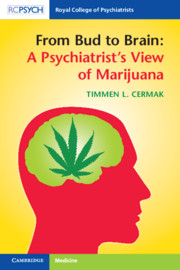Book contents
- From Bud to Brain: A Psychiatrist’s View of Marijuana
- From Bud to Brain: A Psychiatrist’s View of Marijuana
- Copyright page
- Dedication
- Contents
- Foreword
- Acknowledgments
- Introduction
- Section 1 The Science of Marijuana and the Brain
- Chapter 1 Monumental Marijuana Discoveries
- Chapter 2 Marijuana’s Acute Effects
- Chapter 3 Flies in the Ointment
- Chapter 4 Epidemiology
- Chapter 5 The Impacts of Ongoing Marijuana Use on the Brain
- Chapter 6 The Impacts of Ongoing Marijuana Use on the Mind: Section 1
- Chapter 7 The Impacts of Ongoing Marijuana Use on the Mind: Section 2
- Chapter 8 The Impacts of Ongoing Marijuana Use on Adolescent Psychology
- Chapter 9 Secondhand Marijuana: Prenatal Cannabis Exposure
- Section 2 The Science and Art of Healing
- Section 3 The History and Art of Marijuana Policy
- Section 4 Epilogue
- Index
Chapter 1 - Monumental Marijuana Discoveries
from Section 1 - The Science of Marijuana and the Brain
Published online by Cambridge University Press: 31 March 2020
- From Bud to Brain: A Psychiatrist’s View of Marijuana
- From Bud to Brain: A Psychiatrist’s View of Marijuana
- Copyright page
- Dedication
- Contents
- Foreword
- Acknowledgments
- Introduction
- Section 1 The Science of Marijuana and the Brain
- Chapter 1 Monumental Marijuana Discoveries
- Chapter 2 Marijuana’s Acute Effects
- Chapter 3 Flies in the Ointment
- Chapter 4 Epidemiology
- Chapter 5 The Impacts of Ongoing Marijuana Use on the Brain
- Chapter 6 The Impacts of Ongoing Marijuana Use on the Mind: Section 1
- Chapter 7 The Impacts of Ongoing Marijuana Use on the Mind: Section 2
- Chapter 8 The Impacts of Ongoing Marijuana Use on Adolescent Psychology
- Chapter 9 Secondhand Marijuana: Prenatal Cannabis Exposure
- Section 2 The Science and Art of Healing
- Section 3 The History and Art of Marijuana Policy
- Section 4 Epilogue
- Index
Summary
Modern marijuana research began in 1964 when Raphael Mechoulam isolated THC, defined its structure and confirmed it is the primary psychoactive chemical in marijuana. After Howlett and Devane demonstrated a cannabinoid receptor in the brain in 1988. Mechoulam isolated anandamide, the first endogenous cannabinoid discovered, 4 years later. The location of CB1 receptors throughout the brain was mapped by Herkenham and their unique presynaptic location discovered by Istvan Katona. The endocannabinoid system functions as a negative feedback homeostatic mechanism regulating the activity of the brain’s other neurotransmitters. Anandamide and 2-AG, the second and more numerous endocannabinoid discovered, are synthesized on demand from arachidonic acid found in cell membranes. Central to all these discoveries is the similarity in molecular structure between anandamide and THC. Researchers had discovered the physical mechanism by which marijuana affects the brain. By matching the f brain areas with high concentrations of cannabinoid receptors with their functions, the specific effect of THC’s mimicry of our natural chemistry began to make sense. The magic of marijuana is in the brain and not in the plant. Marijuana simply drives the endocannabinoid system far from its normal equilibrium.
- Type
- Chapter
- Information
- Publisher: Cambridge University PressPrint publication year: 2020

